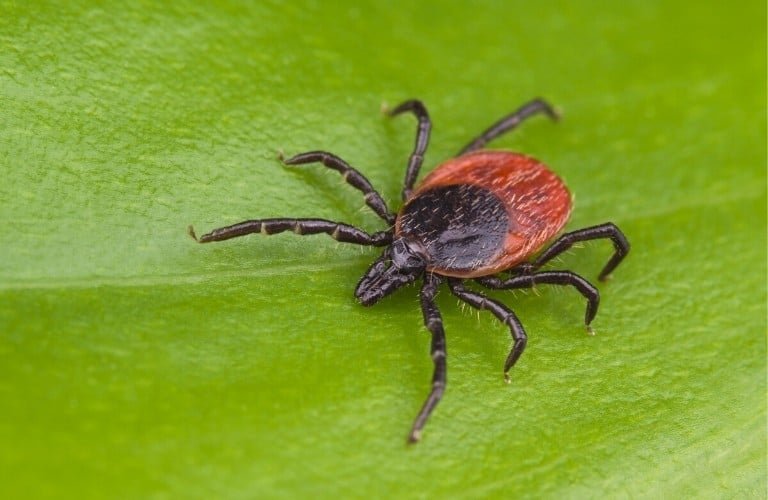If you’ve stayed away from hiking, camping, and other outdoor activities because you’re afraid of getting a tick bite, that’s understandable.
Ticks can transmit a variety of diseases. But, it’s not the end of the world if you do get bitten, so long as you’re able to catch it sooner rather than later.
What happens if you get bitten by a tick? When a tick bites you, it buries its head into your skin and sucks on your blood for nourishment. It may possibly transmit diseases like Lyme disease or Rocky Mountain spotted fever. You won’t feel the bite, but you’ll see a rash or red spot soon after.
Let’s take a look at what happens when a tick bites you and what steps you need to take next.
How to Identify a Tick Bite
Tick bites don’t hurt, which is the main reason why tick-borne illnesses are so common.
Many people don’t know they have a tick feasting on their blood until a red rash appears.
That’s one reason it’s so important to protect yourself with tick-repellent products when outdoors in an area known to have ticks.
In this article, we show you the most recommended sprays to use to keep ticks away.
A tick can feed for up to 10 days without being noticed, which is plenty of time to share its diseases with you.
You may have a tick bite if you notice any of the following:
- There’s still a feeding tick: This may seem obvious, but ticks can be so small that you can’t tell it’s a tick until you look closely.
- Red rash or burning sensation: We’ll get into symptoms in further detail in the next section, but if you notice any kind of rash, bump, or burning, you might have a tick bite.
- Rash appears days following going outside: Ticks are almost always outside, and they only come inside if they’re brought in with their host. If you spent time outside, a rash appearing a day or two afterward is likely to be a tick bite.
- Symptoms appear in moist areas: Ticks appreciate the moist areas of your body, like the armpits and groin, although they’ll bite wherever they please.
- There’s only one bite: You won’t see multiple spots because ticks are solo adventurists and they only bite once.
It should be noted that you can be bitten by a tick but never know about it. Symptoms typically show up with diseases, but not every tick transmits a disease.
You can get bitten and feasted upon for several days and not have any reactions to it at all.
Common Tick Bite Symptoms
As we mentioned before, you can get a tick bite and not have any symptoms if it didn’t carry diseases.
On the other hand, it’s possible to be allergic to tick bites, which means a “clean” tick can bite you, but you’ll still see symptoms caused by your own body rather than a disease.
Tick bite allergy symptoms include:
- A red rash.
- Swelling and burning.
- Blisters.
- Difficulty breathing.
These symptoms should pass on their own, but if you have difficulty breathing or the symptoms linger, contact a doctor as soon as possible.
Although many animals will eat ticks, using predators as a means of pest control could backfire and result a tick infestation. Learn why here.
Diseases Ticks Can Spread
Most symptoms that are seen after a tick bite are related to tick-borne illnesses. Unfortunately, there are several of these in the United States.
On the bright side, not every tick carries one, and if you remove the tick as soon as possible, you’re less likely to contract the disease.
Let’s take a look at some of the most common diseases transmitted by ticks.
Colorado Tick Fever
This disease is transmitted by the Rocky Mountain wood tick, which only lives in the western part of the US and part of Canada.
For more information on where you are likely to run into ticks, see this article.
Most people contract the disease when ticks are most active in the summer months after they’ve spent time outdoors.
The disease will show up in three to six days and will hang around for about 10 days.
Most people don’t have to go to the doctor and can treat the illness at home with plenty of rest and fluids.
If it doesn’t show signs of going away after one week or the symptoms are severe, you should contact a doctor.
Symptoms include:
- A fever as high as 105°F and chills.
- Headache and muscle aches.
- Nausea and vomiting.
- Loss of appetite and abdominal pain.
- Tender skin and a light rash.
- Weakness and fatigue.
Lyme Disease
Lyme disease is one of the most common tick-borne illnesses in the United States. This disease has three stages and starts out as minor but can later become severe.
If it’s noticed and treated in an early stage, you won’t have to worry too much about it.
The disease is transmitted by a black-legged deer tick after it has been feeding on you for 36 hours.
If you remove the tick before 36 hours, you have a much smaller chance of contracting the disease.
Stage 1 of Lyme disease starts one to two weeks after the bite and will have these symptoms:
- Red bull’s-eye-shaped rash.
- Fever and chills.
- Swollen lymph nodes and sore throat.
- Headaches and muscle aches.
- Fatigue.
- Change in vision.
Stage 2 will show up as early as a few weeks or as late as a few months after the bite with the following symptoms:
- Rash appearing in areas away from the tick bite.
- Skin lesions.
- Neurological problems such as tingling, nerve palsies, numbness, and meningitis.
Stage 3 might take a couple of years to show up. These symptoms will occur:
- Arthritis.
- Numbness in the arms and legs.
- Brain disorders including difficulty concentrating, memory loss, and inability to sleep.
The sooner you can identify and treat Lyme disease, the better.
It’s possible for the symptoms of the first two stages to overlap, but since the third stage shows up later, you probably won’t see all of them at the same time.
Rocky Mountain Spotted Fever
RMSF is a severe illness transmitted by the American dog tick, Rocky Mountain wood tick (the same one that transmits Colorado tick fever), and the brown dog tick.
These ticks are found in different parts of the U.S., so it’s safe to say that you can get RMSF virtually anywhere in America.
RMSF is frequently confused with the flu because of the following flu-like symptoms:
- High fever that lasts two to three weeks and chills.
- Headaches and muscle aches.
- Nausea and vomiting.
- Fatigue and loss of appetite.
- Abdominal pain.
The noticeable symptom is a polka dot rash on the hands, wrists, ankles, and feet. The rash shows up about a week after the bite and after other symptoms have appeared.
The rash is a sign that the disease has become serious.
Ideally, you should treat the disease before the rash appears, but this is difficult because you may not even know if you were bitten by a tick.
Making sure that your yard isn’t a welcoming environment for ticks can go a long way toward preventing infestations. Click here to learn how to banish them from your property.
How to Remove a Tick
The CDC has a PDF you can reference with their recommendations for how to treat a tick bite and how to remove the tick.
Removing the tick is the most important part. According to the CDC, the best removal method is:
- Use tweezers to grab the tick as close to its head as you can.
- Pull up and be careful not to twist the tick.
- Wash the area with soap and water.
- Dispose of the tick by flushing it.
For situations when tweezers aren’t available, you’ll have to resort to other measures. Find out what to do here.
If you live in a tick-infested region, it’s a good idea to carry a tick-removing tool, like this Tick Twister, in your purse or pocket whenever you spend time outdoors.
The tool will allow you to safely remove a tick from your skin without having to use tweezers or your fingers.
Some doctors will look at the tick to more easily identify your symptoms.
If you’re able to keep the tick after removing it from your skin, you can place it in a sealed container or bag.
You can keep it in rubbing alcohol or place the container in the freezer and take it to your doctor.
Not every doctor will look at the tick, however, so you don’t have to keep it if you don’t want to.
Final Thoughts
Not every tick bite is serious, but you should always treat it as so. Remove a tick as soon as you spot it so diseases can’t be transmitted.
A tick can’t transmit disease by walking on you – it can only do so when it bites.
Keep an eye out for symptoms for the next 30 days. If you start to have serious symptoms or they resemble a tick-borne illness, contact a doctor right away.
Still have questions about ticks?
Visit our lineup of tick articles to educate yourself about their habits so that you can take the necessary steps to keep yourself and your family safe.




